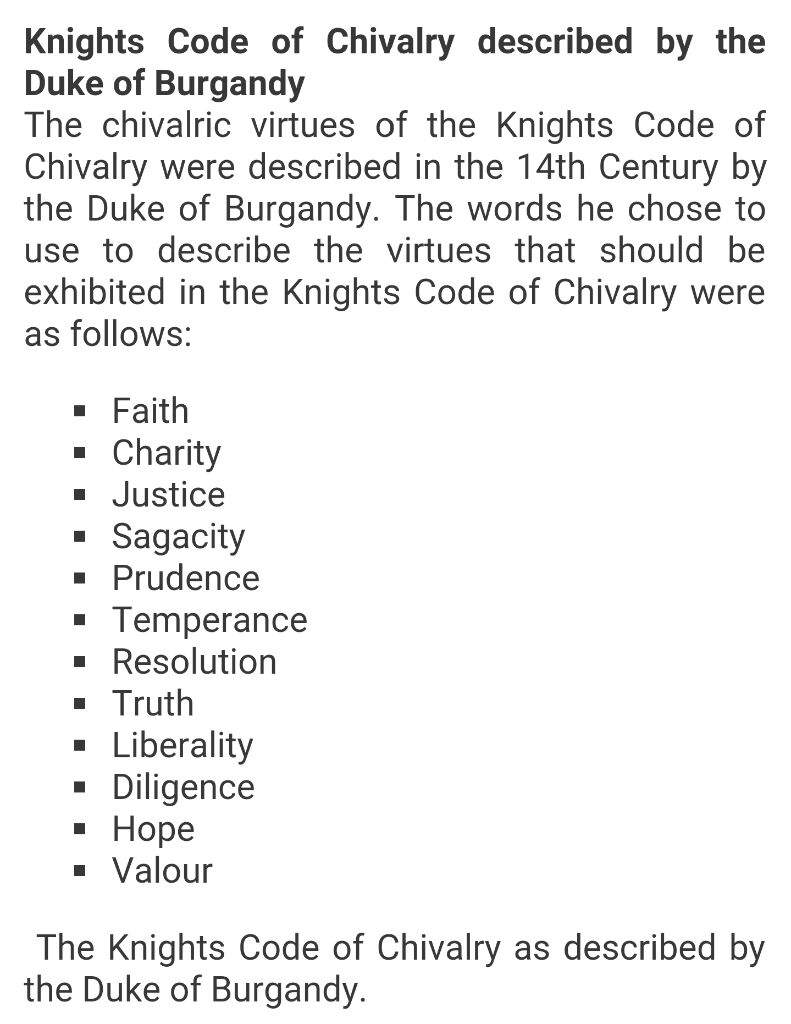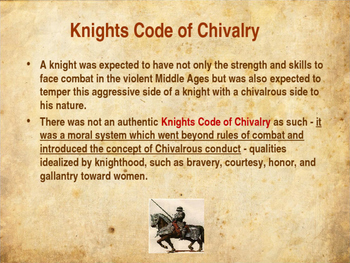

They were to be generous, especially to those who could not be generous in return.

Knights were expected to be honest and fair in their commercial dealings.
#CHIVALRY CODE CODE#
Responsibility to a chivalric code also applied apart from the battlefield and tournament lists.
#CHIVALRY CODE TRIAL#
This idea of holding knights accountable for formal and informal elements of a code of chivalry preview more recent concepts of the laws and customs of war and trial of soldiers by court-martial. Just as important as the ideal of chivalry, there were courts of chivalry, where knights were sometimes tried by a jury of their peers for violations of that code – whether the elements of that code were written or just commonly understood. Both sides expected honor and fairness and each side would accuse the other – often justifiably – when one party violated those norms. Chivalric ideals did not only apply to the knightly class of Europe it also applied to their opponents in Iberia and the Middle East. These included a certain amount of fairness in offence and defense, the protection of non-combatants, and mutual respect among opponents. There was no single code of chivalry, but there were consistent themes. In some ways, chivalric codes began a thousand-year process leading to the concept of the State’s monopoly of violence. Blessed by the Church and in service of the sovereign, chivalry re-directed the warrior class in a way that would constrain rapaciousness, but still leave them useful for necessary military and civil security functions. The concept of chivalry grafted Christian virtues of justice, temperance, prudence, and humility onto a Germanic warrior ethos contrary to all of those virtues. As a semblance of governance arose from the ashes of the Roman Empire in the West, kings and feudal lords needed to control violence in a useful way. Those who are portrayed as the models of chivalrous conduct, whether the mythical Parsifal or the legendary Saladin, were regarded as exceptional.Ĭhivalry as an ideal was a product of the Middle Ages.

The romances of the Middle Ages often featured characters like Lancelot and Gawain who, while aspiring to perfect chivalry, fell short of the ideal. It is also important to understand that, from the beginning, the concept of chivalry was an ideal to aspire to, while recognizing that mere mortals will always fall short of perfection. For example, medieval chroniclers depicted Saladin, a Moslem commander of the 12th century, as an exemplar of chivalry. Some of it is historical revisionism or even historical negation. It is associated with class superiority, misogyny, Western domination, and even “Islamophobia.” Some of this is true. A renewed understanding of the truths of chivalry in our personal and public lives may be a beginning for bringing to life the values we profess.īut what is “chivalry?” The common belief is that it has to do with knighthood, nobility, and romanticism that never existed. In fact, it is the foundation of the laws and customs of war and the limitations we try to apply to the violent business of armed conflict. It also lives in the military ethic of the American armed forces, the British armed forces, and other militaries. There are those few brave souls who spend their lives in seemingly altruistic behavior. Fortunately, chivalry is not completely dead.

The denigration of chivalry is actually an attack on Western civilization and the notions of justice, selfless service, respect for the weak, and the basic equality of all human beings. Insofar as this is true, it tells the story of the slide of civilization to barbarism, or at least the uncivilized world we see around us.


 0 kommentar(er)
0 kommentar(er)
